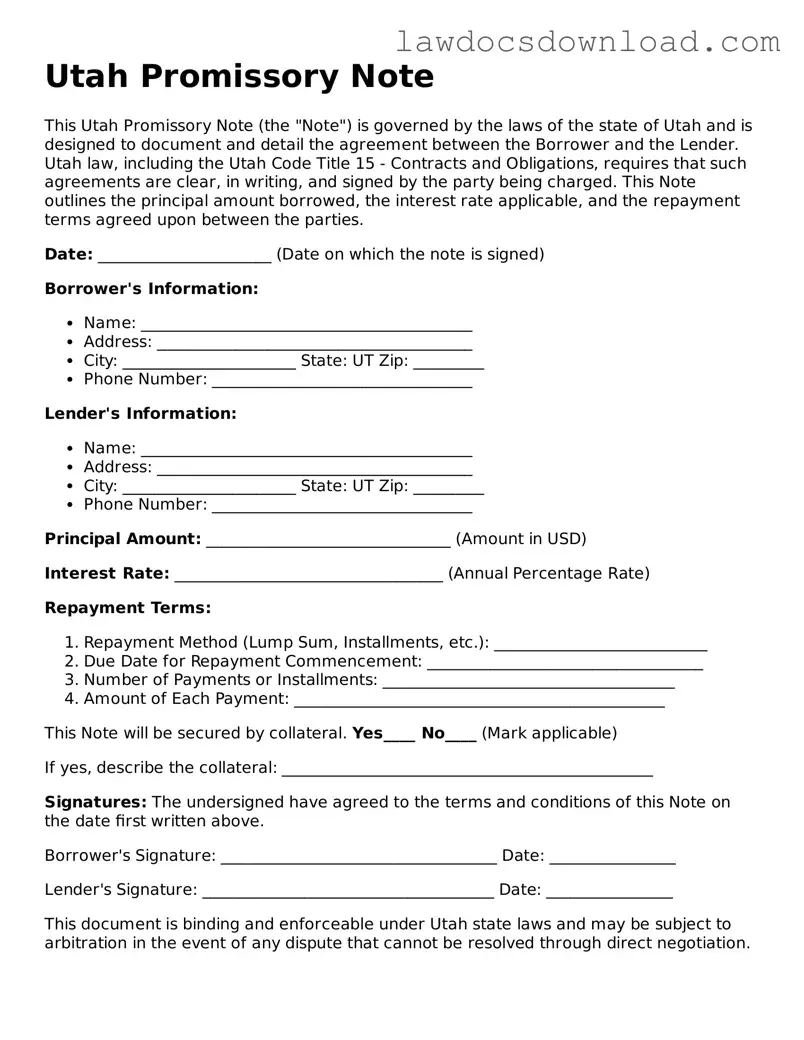The Promissory Note in Utah shares similarities with a Loan Agreement. Both serve as binding legal documents between a lender and a borrower, outlining the terms of a loan. The Loan Agreement, much like the Promissory Note, details the loan amount, interest rate, repayment schedule, and the consequences of non-payment. However, Loan Agreements tend to be more comprehensive, often including clauses on dispute resolution, collateral, and guarantors, making them more detailed in guiding the terms of the lending relationship.
The Mortgage Agreement is another document closely related to the Utah Promissory Note. While the Promissory Note documents the promise to repay a loan, the Mortgage Agreement secures the loan by using the borrower's property as collateral. This means if the borrower fails to repay the loan according to the Promissory Note, the lender has the right to foreclose on the property outlined in the Mortgage Agreement. Essentially, the Mortgage Agreement provides a safety net for the lender, reinforcing the borrower's obligation under the Promissory Note.
Similarly, a Deed of Trust is often paired with a Promissory Note, especially in states where this practice is common. Like a Mortgage Agreement, a Deed of Trust serves as a means to secure repayment of a loan through the borrower's property. However, it involves an additional party, a trustee, who holds the legal title to the property until the borrower repays the loan. The coupling of a Deed of Trust with a Promissory Note ensures the lender's interests are protected by granting them the power to initiate foreclosure through the trustee if the borrower defaults.
An IOU (I Owe You) is a simpler relative of the Promissory Note. It acknowledges that a debt exists, and one party owes another a certain sum of money. While both documents signify an obligation to repay, the Promissory Note is far more formal and includes detailed repayment terms, interest, and potential legal steps in case of default. An IOU, by contrast, is typically less formal and lacks comprehensive terms of repayment, making it less enforceable than a Promissory Note.
The Personal Guarantee is another document related to the realm of Promissory Notes, especially when securing loans for businesses. When a business entity takes a loan, a Personal Guarantee may be required, in which an individual (usually a business owner or executive) promises to repay the loan personally if the business cannot. This guarantee is a testament to the lender of the individual's commitment to the loan's terms outlined in the Promissory Note, significantly reducing the lender's risk.
The Installment Agreement bears similarity to the Promissory Note as well, particularly regarding repayment scheduling. It outlines a plan for repaying a debt in regular installments over a set period. While both documents set terms for repayment of a debt, the Promissory Note typically includes a broader range of details, such as interest rates and consequences of default, and it applies more universally to various types of loans beyond just installment-based repayments.
Last but not least, the Credit Agreement shares traits with the Promissory Note in that it also details the terms under which credit is extended to a borrower. Credit Agreements are often more complex and can cover revolving credit lines, term loans, and other financial arrangements. Although both documents govern the lending process, Promissory Notes are generally used for simpler, more straightforward loans, whereas Credit Agreements can manage a broader array of credit structures and terms.
